Chapter 16: Keeping Your Puppy Healthy
A healthy puppy is a happy companion, and keeping him happy and healthy requires daily feeding, regular grooming, and quality veterinary care. Your puppy is counting on you to take care of him—especially when he is sick—which means you must pay close attention to him every day and be wary of any hint of illness. A number of serious illnesses can hamper your puppy’s well-being, and some breeds are more prone to certain illnesses and conditions than others, though nearly all purebred dogs have some predisposition to disease. For instance, Rottweilers, Doberman Pinschers, and Labrador Retrievers are a few of the breeds at a higher risk of infection from canine parvovirus. According to the Orthopedic Foundation for Animals (OFA), Bulldogs and Pugs have the highest incidence of hip dysplasia; Golden Retrievers and Boxers are more prone to cancer than many other breeds; and Dachshunds and Cocker Spaniels are prone to hypothyroidism, the most common endocrine problem in dogs.
Do you know what a healthy puppy’s eyes, ears, and nose should look like? What about his stools—are they normal looking? Do you know what a dog’s temperature should be? The more time you spend interacting and bonding with your puppy, the more likely you will recognize what is normal. Most owners can recognize the obvious signs of sickness, including vomiting, diarrhea, coughing, nasal discharge, and runny eyes. These are excellent visual indicators that something is wrong. Familiarizing yourself with the more subtle symptoms is equally important. By recognizing these symptoms early on, you help ensure that your puppy grows into a healthy, happy adult dog.
Obviously, dogs can’t talk, so veterinarians use the term clinical signs as opposed to symptoms because it indicates that what is being reported is based on observation, usually by the owner. For the sake of clarity and simplicity, clinical signs and symptoms are used interchangeably here.
Signs of Wellness
Ears, Eyes, Nose, and Mouth
They say that the eyes are the window to the soul, and a puppy’s eyes are certainly a window to his good health—or lack thereof. Your puppy’s eyes should be clear and bright, with no watery or mucous discharge. A healthy dog will occasionally have a small amount of discharge that gathers in the corners of the eyes, which requires periodic cleaning with a clean cloth and warm water. Always question any redness, swelling, squinting, excessive blinking, or closing of the eyelids, which could indicate an injury, a foreign body, viral or bacterial infections, allergies, hereditary conditions, or tumors.
The same goes for your puppy’s ears. Regardless of whether they are bat, button, or cocked ears, a healthy ear should have a clean, healthy smell. Honey-colored wax in the ear is normal, but a crusty, dark substance may indicate ear mites or another problem. Other red flags include ears that have discharge, smell bad, or are red, inflamed, or dark in color. If the puppy is showing signs of discomfort, such as depression or irritability; scratching or rubbing his ears or head; or shaking or tilting his head to one side, it also indicates a problem.
A puppy’s nose should be neither hot nor cold to the touch. Nasal discharge that is any color other than clear could indicate problems caused by allergies, fungal infection, or even cancer.
Puppies should have firm, pink gums and healthy, white (and sharp!) baby teeth. Gums and teeth should be free of bleeding with no visible inflammation or decay. Pale or blue gums are symptomatic of serious health issues, which can include anemia, shock, or lack of oxygen. Bad breath (halitosis) also usually indicates a problem.
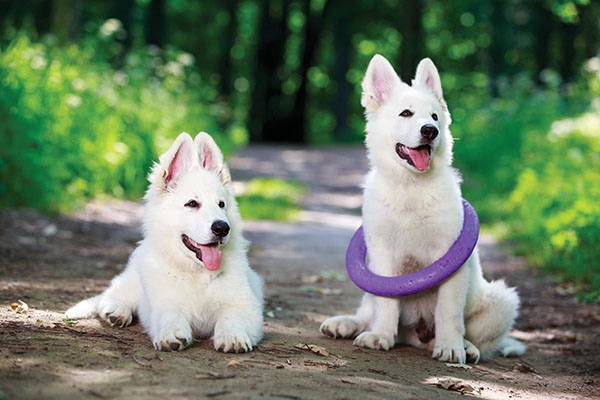
A clean, shiny coat is an excellent indicator of the dog’s overall health.
Coat and Skin
Whether you have chosen a single- or double-coated breed, a dog with long or short hair, or a dog with little to no hair, your puppy’s coat and skin should look, smell, and feel healthy to the touch. His coat should be free of dandruff and neither dry nor broken. His skin should be healthy and pink with no rashes, hot spots, lice, or fleas. Persistent scratching or licking almost always indicates a problem.
Alertness and Movement
Puppies differ in their activity levels. A Shetland Sheepdog or Beagle puppy, for instance, is likely to be more active than a Bullmastiff or a Basset Hound puppy. A happy, healthy puppy should be outgoing and inquisitive, moving freely and unencumbered. Normal canine gait (movement) requires that the bones, joints, muscles, and ligaments work together harmoniously. Lameness may indicate something minor, such as a sticker stuck in a paw or a broken toenail; or possibly something more serious, including a structural issue or injury.
Signs of Illnesses and Emergencies
If you suspect that your puppy is feeling a bit under the weather, it’s always best to err on the side of caution. Many illnesses, such as gastrointestinal disease and cancer, have multiple symptoms that can vary from mild to life threatening. Always consult your veterinarian if you are concerned about your puppy.
Bleeding
Bleeding from your puppy’s nose or mouth and blood in the urine, stool, or vomit suggest a serious health issue. A puppy exhibiting any of these signs should be taken to the veterinarian immediately. Prolonged bleeding from a cut or puncture wound may be indicative of a damaged artery or vein. Bandaging can be dangerous if not done correctly. Seek immediate veterinary attention.
Breathing Problems
Anything that indicates abnormal breathing, including shallow, rapid, noisy, or breathy breathing; open-mouth breathing while resting; gagging; or pale or bluish-colored gums or tongue, should be checked by your veterinarian. Any number of medical issues can cause difficulty breathing; these include obstructions, ruptures, swelling, pneumonia, bleeding, or heartworms, to name a few. Many brachycephalic breeds have noisy or impaired breathing, which may be reasonably normal, considering their compromised airways.
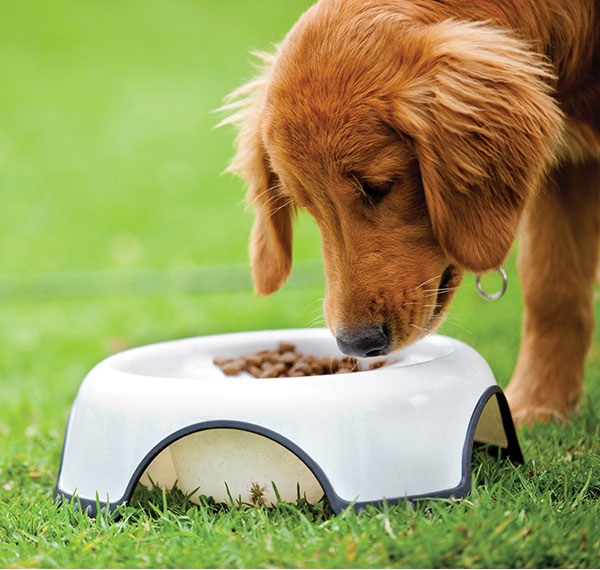
A lack of enthusiasm at the breakfast buffet is a sure sign that your puppy isn’t feeling well.
Changes in Appetite
Be observant of your puppy’s eating habits. An increase or decrease in his appetite may be worth consulting your veterinarian. If your puppy is not feeling well, it stands to reason that he may not feel like eating much (just like humans who are feeling ill). If your normally ravenous puppy goes off his food temporarily, it may be something minor. If his lack of appetite persists or is out of character for your puppy, it may indicate a broken tooth or something more serious. If accompanied by lethargy, vomiting, diarrhea, weight loss, or other signs of illness, consult your veterinarian immediately.
An increase in appetite may be a normal response to an increased need for nutrients. Exercise, cold temperatures, and pregnancy are examples of normal situations that require increased food and nutrition. Although some diseases can increase a puppy’s need for extra nutrients, it is more likely that your ailing pup will experience a loss of appetite. Some medications—especially corticosteroids—can increase a puppy’s appetite or thirst. Unless you monitor your puppy’s food intake daily with scheduled feedings, as opposed to free feedings, you may not notice an increase or decrease in appetite.
Changes in Water Consumption
Like food intake, water consumption varies with environmental temperature, exercise, and diet. (Puppies who eat dry food usually require additional water.) Hot weather and vigorous exercise increase a puppy’s water requirements. If you notice that your puppy is drinking more or less water than normal and/or urinating more or less than usual, it could be voluntary or involuntary. Voluntary decreases in water are often associated with other signs of disease, such as lethargy, vomiting, diarrhea, and fever, and may be indicative of diabetes or kidney issues. Involuntary decreases in water usually stem from cold weather that freezes a water bowl, making fresh water inaccessible; or from the owner’s failure to replenish the dog’s water bowl. Dogs that don’t drink enough water run the risk of dehydration, which is a serious problem.
Changes in Urination
Urination is a complex process, with urine carrying waste products out of a dog’s body and keeping his internal environment balanced. Male and female urination patterns differ, with a lot of factors working together to form urination habits. Puppies urinate more frequently than adult dogs because they lack bladder control until about six to eight months of age. Like water consumption, changes in urination can be voluntary or involuntary. If your puppy is urinating more frequently or passing more urine when he does his business, if he appears to be experiencing pain or straining, or if you notice a change of color or blood in his urine, you should have him checked by a veterinarian right away. Any number of medical issues, including infections, obstructions, urinary stones, ingestion of toxins, and cancer, can cause changes in urination.
Of course, if your puppy lives in the house with you and is closely supervised, as opposed to spending the majority of his day outside, you are more likely to notice a problem should it arise.

Don’t let Jaws Jr. chew on everything he finds in the yard. Choking on a foreign object can occur in a matter of seconds.
Choking
Puppies that are choking can be extremely anxious and may even attempt to bite. If your puppy is choking on food or a foreign object, you can try to remove it by performing a mini-Heimlich maneuver—similar to the human procedure. Press quickly around the chest to force an object out of the upper throat area. If his gums and tongue are pale or blue, he is not getting enough air and requires immediate veterinary attention. Don’t delay.
Constipation
If your puppy is straining to defecate, or if he has not passed feces for several days, contact your veterinarian. It could simply be constipation, which is often confused with more serious issues, such as inflammatory bowel disease (IBD), also known as chronic colitis. Gastroenteritis or impacted or infected anal sacs could also be culprits.
Constipation can result from a number of reasons, including overly long confinement while traveling or a diet lacking in fiber and water. Tumors or trauma can also be a contributing factor. Intestinal blockages caused by bones, corncobs, rocks, fruit stones, food wrappers, wood chips, bottle caps, or countless other foreign objects is a common cause of constipation.
An intestinal blockage can be life threatening. If you suspect that your puppy has swallowed a foreign object, seek veterinary attention right away. Diagnosis is usually made with an X-ray of the gastrointestinal (GI) tract. Absent GI blockage, and if no other symptoms are present, medication may be all your puppy needs to start feeling better. Always consult with your veterinarian before giving over-the-counter medications to your puppy.
Coughing
Have you ever heard your puppy cough? Coughing can sound either harsh and dry or moist and wet. Depending on the quality of the cough, it can be indicative of infection, obstruction, allergies, structural abnormalities, parasites, pneumonia, trauma, blood-clotting disorder, heart or lung issues, or various other medical issues.
Diarrhea
Diarrhea can indicate a disease or illness, such as infection, defective transport of nutrients, or internal parasites—especially if it persists longer than twenty-four hours. It could be a result of overeating, eating spoiled or rotten food, a change of diet, stress, or too much excitement. If your puppy has additional symptoms—vomiting, lethargy, loss of appetite, weight loss or blood in the stool—it warrants an immediate trip to the veterinarian. If possible, take a stool sample with you.
Dizziness or Lack of Balance
Puppies stumble and fall all the time while playing, as if their uncoordinated bodies can’t keep up with their brains. Dizziness or lack of balance is a separate issue and should not be ignored because it can indicate of multiple health issues, including infection, dehydration, or toxin ingestion, to name a few.
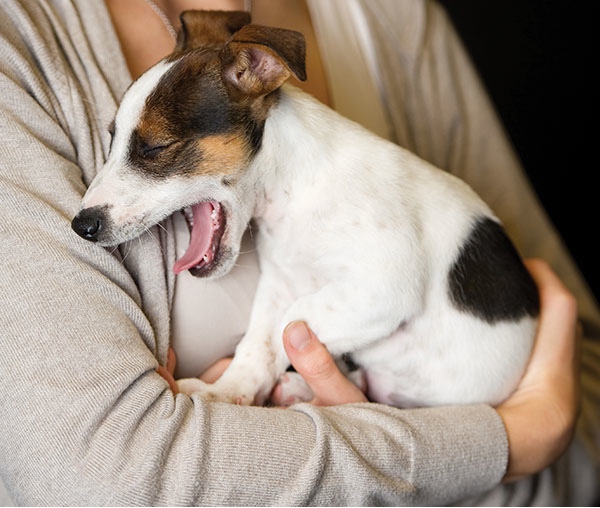
This sluggish little slugger is not his usual wild “Jack” self.
Lethargy
If your happy, active puppy isn’t his normal self and is acting unusually drowsy or dull, it is worth taking a closer look. Lethargy or restlessness is an important sign that your puppy is not well and could indicate any number of diseases or illnesses, including parvovirus or bloat. Always err on the side of caution and consult your veterinarian.
Limping or Stiffness
A normal gait requires a puppy’s muscles, ligaments, bones, and joints to move together harmoniously for maximum efficiency. Limping, stiffness, or general problems with a puppy’s gait could indicate a bone or joint problem. It, of course, could be something very insignificant, such as a splinter in a pad or untrimmed nails. Symptoms vary from subtle pain or tenderness to an inability to place any weight on a limb. Be sure to let your veterinarian know.
Pawing at the Mouth
Pawing at the mouth may mean that something is stuck or embedded in the puppy’s mouth, in the gums, or in or under the tongue, or that he is choking. Check inside your puppy’s mouth immediately; he could have a stick wedged behind his jaws or have something clumped inside his cheek.
Your puppy may rub his face on the floor, drool, gag, lick his mouth repeatedly, or hold his mouth open. A condition left untreated can result in an abscess, with the principal signs being lethargy, bad breath, and refusal to eat.
Scratching or Itching
The skin condition is a general indicator of a puppy’s health, and poor skin condition usually means that something is amiss. Excessive scratching or itching, hot spots, rashes, or patches of missing fur indicate an underlying issue. Among the wide range of possibilities are flea allergy dermatitis, parasites, fungal infections, allergies, and poor diet. Hormonal issues such as hypothyroidism and Cushing’s disease can also contribute to skin problems. A puppy suffering from skin issues is no doubt miserable, so take him to your veterinarian right away.
Shaking or Trembling
Puppies shake and tremble when they are excited—such as when they see their owners! Otherwise, shaking and trembling can indicate shock and/or the puppy’s fight or flight instinct. It also may indicate any number of issues, including injury, pain, nausea, poisoning, or kidney disease. Seek veterinary attention right away.
Swelling
Swelling of the muzzle area often results from an insect bite or bee sting. Veterinary attention depends on the severity of swelling and whether or not there are accompanying symptoms, such as vomiting, diarrhea, drooling, or collapsing. When in doubt, always seek veterinary attention.
Temperature
The normal rectal temperature of a dog is 101°F to 102.5°F or 38.3° and 39°C. An increase in temperature can be caused by excessive exercise or excitement as well as a rise in the environmental temperature (e.g., a heat wave, the dog’s being confined to an enclosed car, or the dog’s being left outside in the yard with no shade). An elevated temperature can be indicative of a problem, which includes infection, abscess, internal parasites, or other health issues.
Vomiting
Dogs vomit for all sorts of reasons and, unlike humans, they occasionally do so with little discomfort. Dogs vomit when they get excited, drink too much water too fast (especially after exercise), gulp their food, go for car rides, or eat grass.
If your puppy appears to be healthy, a single vomiting episode should not send you running to the vet. It may be nothing more than a mild stomach irritation. Persistent vomiting can mean a severe problem, especially when it is seen in combination with other symptoms, such as lethargy, pain, fever, diarrhea, stomach bloating, listlessness, labored breathing, or blood or bile in the vomit. Causes can include an intestinal blockage, ingestion of toxic substances, or an infection, to name a few.
Persistent vomiting indicates that something is wrong and also can lead to loss of water and important electrolytes. Contact your veterinarian right away and bring a sample of the vomit with you.
Now that you are familiar with the characteristics of a healthy and unhealthy puppy, you are more likely to recognize when things are amiss.
Vaccinations: The Controversy
Vaccinations are very important to your puppy’s health. They were developed to save lives, and they do, but vaccination procedures have come under fire for a number of years. Google “canine vaccines,” and you will discover more than a million results, with countless articles arguing the pros and cons. Decoding fact from fiction is daunting, but arming yourself with the basic facts and sorting through the hype are important to your puppy’s future health and well-being. One thing is certain: when it comes to vaccinations—one size does not fit all.
The bottom line is that most experts agree that vaccinations are an important part of preventive care and essential when it comes to keeping your puppy healthy. The majority of veterinarians supports puppy vaccinations and the need to vaccinate all dogs against rabies. However, the rules for vaccinating dogs have changed in recent years, and therein lies the controversy. Many experts feel that puppies are vaccinated too early and too often, and with too many vaccines at once. What does this mean to you and your puppy? Let’s take a look.
Fifty years ago, researchers and veterinarians understood much less about immunology and the long-term medical effects of vaccinations, be they beneficial or harmful. Also, fewer infectious diseases existed, hence fewer vaccines. Not so long ago, the vaccination process was pretty simple: vaccinate for everything and vaccinate often. Dogs were vaccinated on an annual basis regardless of breed, lifestyle, or risk of exposure to a disease. Prior to 2003, when the American Animal Hospital Association (AAHA) published its first canine vaccine guidelines, veterinarians relied on the vaccine manufacturers’ one-year recommendations for guidance. Modern science and new technology have helped to improve the quality and duration of immunity (DOI) for many vaccines, which captures the controversy in a nutshell. Should you continue to vaccinate your puppy even when he has immunity?
Studies indicate that seven years after a dog is vaccinated for rabies, he still has antibodies at levels known to provide immunity. Additional studies indicate that the DOI for canine parvovirus can be seven years postvaccination, and distemper immunity can extend five to fifteen years, depending on the strain. In other words, the duration of immunity is much longer than one year and even the three-year vaccination schedule currently recommended.
While many veterinarians still recommend annual boosters to protect against the most common canine diseases, an estimated 40 to 50 percent of US veterinarians now recommend a three-year booster schedule, recognizing that overvaccination may jeopardize a dog’s health. The judicious use of vaccines, they say, is paramount. Others advocate rotating yearly vaccines using a single-component vaccine for each disease—a vaccine, for example, that contains only parvovirus rather than a combination vaccine for parvovirus, distemper, and hepatitis.
The long-term health risks associated with vaccinations have yet to be clearly defined, and many question the necessity of vaccinating for Lyme disease, Giardia, or even rattlesnake bites.
There is no question that some vaccinations are an absolute necessity and that modern medicine and technology will help keep your puppy happy and healthy. Veterinarians are slowly coming to terms with the risks and side effects associated with vaccines, but the controversy surrounding them is not likely to fade anytime soon. Proper vaccination protocol includes vaccinating only healthy dogs, vaccinating at the appropriate ages, and following an appropriate vaccination schedule. Your puppy’s lifestyle, where you live, and how much traveling you plan to do will factor into your puppy’s vaccination plan. Therefore, it is important to discuss with your veterinarian a program to help your puppy grow into a happy, healthy adult dog.
Titer Instead of Vaccination?
A titer test is a simple blood test that measures the amount of antibodies that develop after a puppy (or adult dog) is vaccinated or after exposure to an infectious disease. It indicates whether a puppy has enough protection—or effective immunity—against a disease, such as parvovirus, distemper, or hepatitis. (A blood titer for rabies is available, but currently no state will accept a titer in lieu of a rabies vaccination.) Blood titer results allow a veterinarian to determine if a booster vaccination is necessary. Many owners go this route to avoid the side effects that can be associated with vaccinating or overvaccinating their dogs. While there appears to be no downside, not all veterinarians support titering in lieu of booster vaccinations, believing it is not a valid method of determining a dog’s immunity to infectious diseases. And, of course, there is the cost of a titer test, which is considerably more expensive than that of a vaccine. As with all things pertaining to your dog, consult with your veterinarian and do your due diligence.
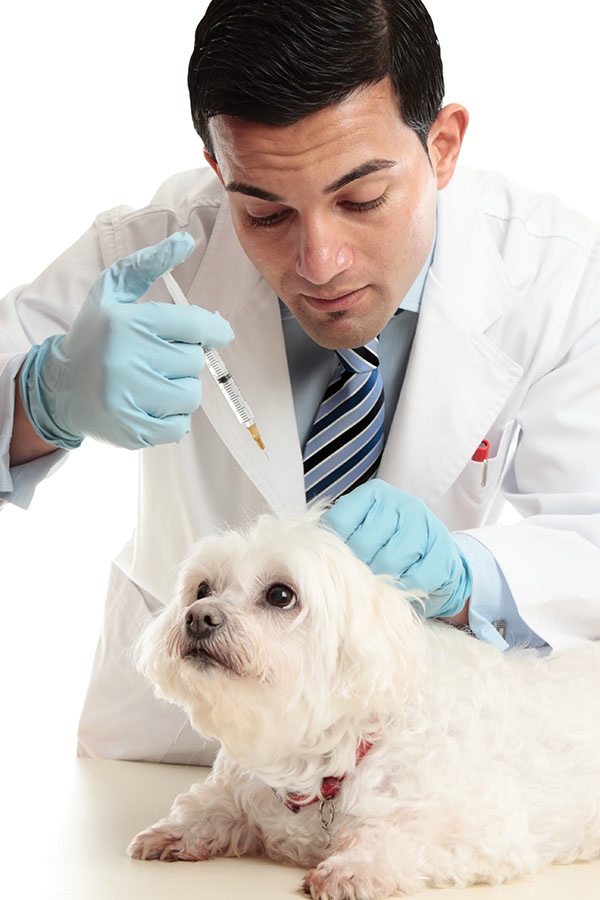
The frequency of vaccinations and the combination of different vaccines are two important questions to discuss with your vet.
How They Work
Vaccines are designed to trigger a protective immune response and prepare a dog to fight future infections from highly contagious and deadly disease-causing agents. Think of your puppy’s immune system as a border patrol that guards his body against foreign invaders. When your puppy is vaccinated or exposed to something foreign, or nonself, such as bacteria or viruses, his immune system reacts by producing antibodies or sensitized lymphocytes (a type of white blood cell) that seek out and destroy the intruders. This is called active immunity. These fighting cells not only destroy the organism but also remember what it looked like so they can fend it off in the future, preventing or minimizing illness if a puppy is exposed to the same organism again. In other words, this immunological memory enables vaccines to protect a puppy against future disease long after the original infection.
When puppies nurse, they receive immunity from their mother through colostrum (first milk), which is rich in antibodies and provides passive immunity. These maternally derived antibodies (MDAs) provide adequate protection for six to sixteen weeks. The exact age at which these MDAs disappear will vary greatly from one puppy to another. The same MDAs that help protect your puppy also can interfere or block the ability of vaccines to do their job because MDAs do not distinguish between the real virus and the vaccine virus. In other words, the vaccine is inactivated or neutralized by the presence of MDAs.
To overcome this problem, vaccines are generally administered as a series of inoculations. The AAHA (2011) guidelines recommend that puppies receive their vaccinations every three to four weeks between the ages of six and sixteen weeks, depending on the vaccine that is being used and the disease being vaccinated against. Because experts assume that most puppies nurse from previously immunized females, and therefore consume significant quantities of MDAs within the first three days of life, many strongly recommend that all puppies receive the last dose in the initial series of core vaccines at fourteen to sixteen weeks of age, more specifically between fifteen and sixteen weeks of age, as many puppies maintain interfering levels of antibodies until fourteen weeks of age.
By giving a series of vaccinations, the period during which puppies are most susceptible to natural infection is minimized. The goal is to minimize the puppy’s susceptibility to disease by immunizing as close as possible to the time that MDA levels are low enough to not interfere with the vaccine. For example, if a puppy loses his MDA protection at eight weeks of age and is not vaccinated until sixteen weeks of age, he will be unprotected for eight weeks. If, on the other hand, a puppy loses his MDA protection at seven weeks of age and receives his first vaccination at eight weeks of age, the period of relative susceptibility is much shorter.
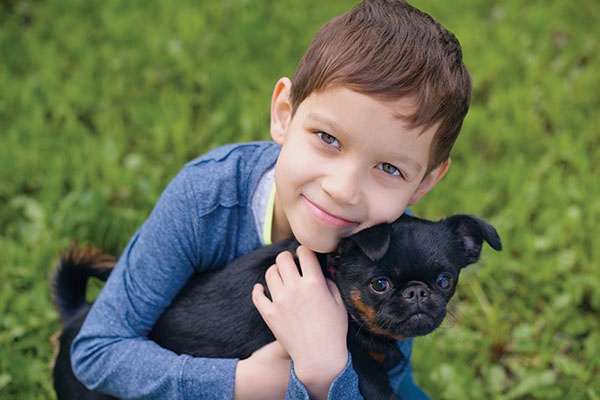
While recommendations will vary from puppy to puppy, most vets agree that all dogs must be initially vaccinated against the four core diseases.
Core Vaccines
Due to the multitude of vaccines available and the recognition that not all dogs need all vaccines, the AAHA vaccination guidelines center on core and noncore vaccines. Core vaccines are considered essential for every dog because they help to prevent against high-risk, highly contagious, and potentially fatal diseases.
The breeder from whom you acquired your puppy may have administered your puppy’s first puppy shots. If so, you should have received a copy of the date and type of vaccine, which you need to take to your puppy’s first vet visit. Veterinarians differ in their vaccination protocol, but most inoculate against the four most common diseases, distemper, hepatitis, parvovirus, and rabies.
Distemper: Highly contagious and potentially fatal, distemper is similar to the human measles virus. Puppies less than six months of age are most susceptible. Spread through the air or direct contact with an infected animal’s urine, feces, or saliva, distemper affects many organs, including the skin, the respiratory system, and the nervous system. Symptoms usually include nasal and eye discharge, coughing, diarrhea, and vomiting.
Hepatitis: Canine hepatitis typically affects the liver, tonsils, and larynx but can also attack other organs. Spread primarily through infected fluids, including saliva, nasal discharge, and urine, symptoms include a sore throat, coughing, and occasionally pneumonia. It spreads rapidly to other organs and develops quickly; dogs can die within hours of exhibiting symptoms. Unvaccinated dogs of all ages are at risk, but it is most prevalent in puppies less than one year old.
Parvovirus: A highly contagious and life-threatening gastrointestinal disease, canine parvovirus (CPV) has been documented since the late 1960s, and particles are literally everywhere, in every environment. Sterile environments can be quickly reinfected because the virus is shed in large amounts in the stools of infected dogs for several weeks following infection and can be carried on a dog’s feet and hair, as well as on shoes, clothing, tires, pet crates, and other animals. CPV is extremely hardy, and viral particles are capable of surviving for months in the environment—even through winter.
CPV normally affects puppies, but unvaccinated dogs of all ages are susceptible. For unknown reasons, some breeds, including Rottweilers, Doberman Pinschers, Labrador Retrievers, American Staffordshire Terriers, and German Shepherd Dogs, are at a higher risk of infection. The typical incubation period is three to seven days between initial infection and onset of symptoms, which include diarrhea (oftentimes bloody or odorous), vomiting, and dehydration. Lethargy, depression, and loss or lack of appetite, followed by a sudden onset of high fever, may also occur.
Diagnosis is confirmed with an enzyme-linked immunosorbent assay (ELISA) with results normally available within fifteen minutes. The gold standard for treatment consists of intensive veterinary management, including intravenous fluids to control dehydration and antibiotics for infection, which almost always require a costly hospital stay. Oftentimes, the cost is prohibitive for many owners who do not have veterinary insurance.
Colorado State University’s College of Veterinary Medicine is providing owners of infected puppies with a more affordable at-home treatment protocol that consists of a long-acting antibiotic injection, a daily injection of an antivomiting medication, and administration of subcutaneous fluids. Data indicates an 85 percent survival rate compared to a 90 percent survival rate with inpatient care. Puppies who recover from CPV-2 infection acquire lifelong immunity.
Preventing Parvo
Parvovirus is a highly contagious and often lethal gastrointestinal disease. To keep your puppy safe, experts recommend the following:
Vaccinate your puppy. Puppies have immunity from their mother early in life but should receive their first vaccination between six and eight weeks of age and then two boosters at three-week intervals. Many experts recommend administering the final vaccination at sixteen weeks of age to avoid maternal antibody interference.
Avoid taking your puppy to high-risk areas, such as dog parks, pet stores, doggy-daycare centers, boarding kennels, and other areas frequented by dogs until the puppy has received his complete set of vaccinations.
If you suspect your dog has been exposed to parvovirus or if he shows symptoms (vomiting or diarrhea), seek veterinary attention immediately. Time is of the essence.
Parvovirus History
Nearly every mammal species, humans included, has its own parvovirus, with each virus being specific to the animal it infects. Therefore, the pig parvovirus will not infect humans; the human virus will not infect cats; the feline virus will not infect dogs, and so on.
The original canine parvovirus, discovered in 1967 and called CPV-1, did not represent much threat, except to newborn puppies. Experts believe that it mutated from the well-known feline panleukopenia virus (FPV). Around 1978, a new variant, CPV-2, emerged, but no dogs had immunity against the virus, which resulted in a CPV epidemic. By 1979, a second and even more aggressive virus, CPV-2a, emerged. In 2000, yet another virulent strain known as CPV-2c was discovered in Italy, with the first case in the United States being confirmed in 2006.
Rabies: A highly infectious viral disease that affects the brain, rabies is almost invariably fatal once symptoms begin to appear. All warm-blooded animals—including humans—are at risk, with rabies still being prevalent in many parts of the world. Transmission of the virus is almost always from a bite from a rabid animal, such as a bat, raccoon, or skunk. The virus is relatively slow moving, with the average incubation time from exposure to brain involvement (in dogs) being between two weeks to six months. Behavior changes are frequently the first symptom, and infected dogs have trouble swallowing and will drool or salivate. Advanced symptoms include paralysis and convulsions. Although the disease is incurable, properly vaccinated animals are at a relatively low risk of contracting the disease. Vaccination protocol varies from state to state. Always err on the side of caution and seek veterinary assistance immediately if you suspect a wild animal or an infected dog has bitten your puppy.
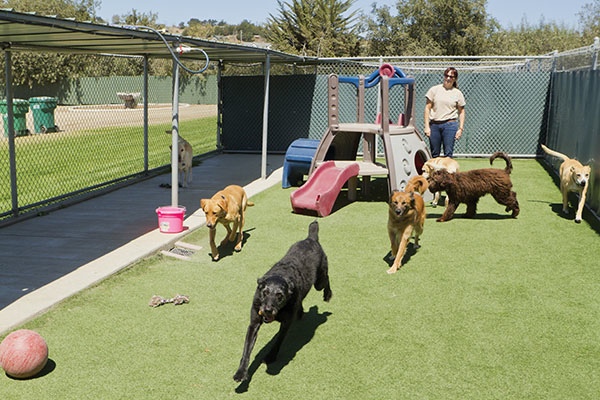
Dogs that are boarded or attend doggy day camp will need to be vaccinated for kennel cough in addition to receiving his core vaccines.
Noncore Vaccines
Noncore vaccines are sometimes referred to as “lifestyle” vaccines and are recommended based on geographical location, likelihood of infection, and a dog’s individual risk factor. For example, does your puppy go to doggy daycare or play with other dogs at the dog park? Do you board him or bring him to dog shows or trials? Does the geographic area where you live or travel with your dog have increasing outbreaks or incidences of a particular disease, such as parvovirus or kennel cough?
Kennel Cough: Also known as canine infectious tracheobronchitis, kennel cough is highly contagious and normally characterized by a harsh, dry, coughing or hacking, which may be followed by retching and gagging. Caused by the bacterium Bordetella bronchiseptica, the disease is airborne—meaning it is passed through the air—and can spread rapidly among dogs who live together. Four to six days is the normal incubation period. Dogs at shows, boarding kennels, grooming shops, veterinary clinics, and dog parks are at an increased risk to exposure. The disease is rarely dangerous to healthy dogs, and most puppies will recover in a week or two, while others may develop secondary bacterial infections, bronchopneumonia, or chronic bronchitis, with symptoms lasting for many weeks. Diagnosis is made based on a case history (e.g., recent kenneling or exposure to infected dogs), and the unmistakable and characteristic honking or harsh cough. Treatment often is limited to letting the cough run its course. Some veterinarians may prescribe antibiotics for secondary bacterial infections, cough suppressants, or fluid therapy to maintain normal hydration if necessary.
Leptospirosis: Transmitted primarily through the urine of infected animals, spiral-shaped bacteria known as leptospires can get into water or soil and survive for weeks to months. Warm, stagnant, or slow-moving water is a haven for leptospires.
Contaminated urine can infect dogs and humans as well as vegetation, food, soil, water, and even bedding. Most infections occur when a dog or human goes swimming in or drinks water harboring these bacteria. The leptospires enter the body through mucous membranes or abraded skin, where they enter the bloodstream and multiply rapidly. After reproducing in the bloodstream, the bacteria invade their target organs, including the kidney and liver.
Symptoms vary from dog to dog and can include fever, joint or muscle pain, vomiting, abdominal pain, diarrhea, loss of appetite, nasal or eye discharge, jaundice, weakness, and lethargy. Some dogs are asymptomatic but can be severely ill and die spontaneously.
Diagnosis is based on clinical observations as well as on laboratory testing of blood and urine. Treatment generally consists of antibiotics to control the bacterial infection. More advanced stages may require intravenous fluids to treat dehydration and to compensate for abnormal liver and kidney functions. In severe cases, a blood transfusion may be necessary.
Prognosis depends on the puppy’s age and immune response and the strain of bacteria. Once kidney and/or liver failure is present, the prognosis for recovery is worse.
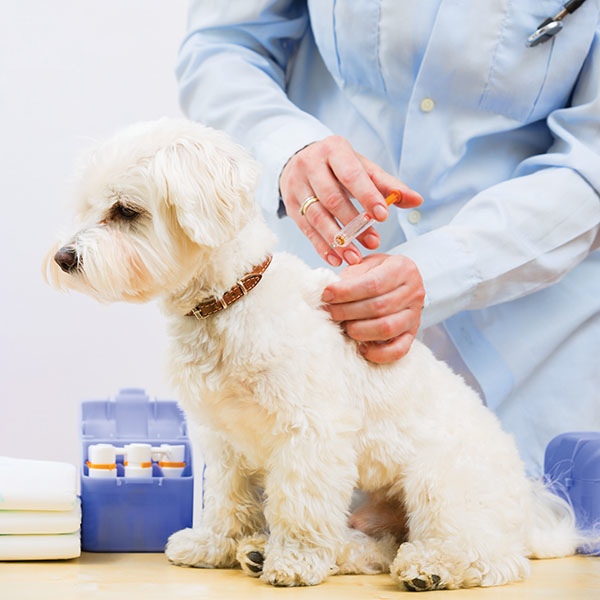
If you live in a high-risk area for Lyme disease, your vet will likely recommend the vaccine.
Lyme Disease: Depending on where you live, your veterinarian may choose to vaccinate against Lyme disease—a bacterial infection caused by corkscrew-shaped bacterium identified as Borrelia burgdorferi. Named for the town of Old Lyme, Connecticut, where it was discovered in the 1970s, Lyme disease is transmitted to humans and dogs through the bite of an infected deer tick. Illness may not show up for months after initial exposure to an infected tick, and the severity of the disease may vary depending on the dog’s age and immune status.
Fever, shifting-leg lameness, swelling in the joints, and lethargy are the most common symptoms. Lameness occurs an average of two to five months after tick exposure. Symptoms are often reoccurring, which makes the disease difficult to cure. Occasionally, Lyme disease develops into a chronic state, becoming a “waxing and waning” illness in which the symptoms come and go.
Diagnosis includes history of exposure to ticks in an endemic area, typical clinical signs (lameness with or without fever), a positive antibody test, and a prompt response to antibiotic therapy. The enzyme-linked immunosorbent assay (ELISA) is useful for diagnosis if the dog has not yet been vaccinated against Lyme disease. (Many vaccinated dogs develop antibodies that the ELISA and other tests can’t distinguish from a dog’s antibody response to tick exposure.)
Treatment usually consists of antibiotics. Prognosis is good, with most dogs responding well to antibiotic treatment and complete recovery expected in the majority of cases.
Parainfluenza: This virus is one of several viruses attributed to kennel cough in dogs. It is easily spread when a dog coughs, which is one of the primary symptoms.
A highly contagious respiratory infection that emerged in the United States in 2003, it is closely related to the virus that causes equine influenza, which is thought to have mutated to produce the canine virus. Easily spread by airborne respiratory secretions (e.g., a dog coughing or sneezing), the virus is commonly mistaken for kennel cough because the symptoms are similar. Symptoms include dry or hacking cough, fever, difficulty breathing, runny nose, sneezing, runny eyes, eye inflammation or conjunctivitis, loss of appetite, and lethargy. Symptoms may persist for ten to thirty days or even longer, despite antibiotics and cough suppressants. Some dogs progress to a more severe form of the illness that is complicated by pneumonia. A small percentage—5 to 10 percent—of the severe forms are fatal. Approximately 20 to 25 percent of infected dogs are asymptomatic, but can still shed the virus.
Treatment generally consists of antibiotics, cough suppressants, and supportive treatment, including hydration. Any situation that brings dogs together increases the risk of infection; however, high dog populations at places such as doggy daycares, boarding kennels, and pet stores are most problematic.
Specific Circumstances
Some noncore vaccines may be considered core vaccines because they are designed to prevent a disease that is a potential health threat. Vaccines as a preventive measure may be wise if your puppy will be in crowded public areas or at events with other dogs. Some boarding or grooming facilities insist on vaccines for upper respiratory infections as well. However, these vaccines are not 100-percent protective, and you should request the opportunity to sign a waiver for exemption of this requirement.
Discuss with your veterinarian your puppy’s risk of exposure to the various canine illnesses so that you can develop a vaccination schedule tailored specifically for him. This will avoid giving your puppy unnecessary vaccines, which may pose a risk of adverse reactions by introducing foreign substances from vaccine components into his young body at a vulnerable time.
Additional Options
The AAHA classifies some vaccines as “not recommended,” but your veterinarian may choose to vaccinate your puppy based on his specific circumstances.
Coronavirus: Spread through the stool of infected dogs, coronavirus is a highly contagious intestinal infection. Symptoms include vomiting, loss of appetite, and acute diarrhea, which may lead to dehydration, further endangering puppies. Puppies less than twelve weeks of age are at the greatest risk. Laboratory tests are necessary to differentiate coronavirus from the deadly canine parvovirus.

The tall tales of puppyhood: “That snake was 90 feet long, and, yes, I killed it to keep you two cool cats safe.”
Crotalus Atrox (Rattlesnake) Venom: The efficacy and experimental challenge data in dogs for this vaccine is not yet available. However, for owners living in high-risk areas, where rattlesnakes are common, this vaccine may buy your dog the time he needs until emergency veterinary help is reached. It is intended to protect dogs against the venom associated with the bite of the western diamondback rattlesnake but may have some cross-protection against other rattlesnakes.
The vaccine works by stimulating a dog’s immune system to develop neutralizing antibody titers, and it helps lessen the dog’s potential reaction to a snake bite. For the vaccine to be effective, a dog must be inoculated at least thirty days prior to a bite. The vaccine does not prevent all reactions and does not negate the need for emergency veterinary treatment should a dog be bitten.
External Parasites
Parasites are not exactly dinner-table conversation—except among a few diehard dog enthusiasts—but it is a conversation you need to have with your veterinarian. Keeping your pet healthy is much easier if you understand and recognize the most common parasites before they lead to major health issues. Few owners get through their dog’s lifetime without the dog’s suffering from external or internal parasites. Most of these parasites are tiny, but, left unchecked, they can wreak havoc, causing debilitating and life-threatening problems.
For the sake of simplicity, parasites are divided into two broad categories: internal parasites and external parasites. Internal parasites, such as worms, live inside the host (i.e., your puppy), primarily in the gastrointestinal tract, liver, and lungs. External parasites, such as fleas and ticks, are found on or within the host’s skin. External Parasites
Fleas and ticks are real problems for puppies, as well as adult dogs, because they can get out of control very quickly. Keeping one step ahead of these pesky creatures is the best way to ensure that your puppy stays happy, healthy, and comfortable.

Longhaired dogs, such as this plushly coated Pomeranian, can be a challenge to keep flea-free.
Fleas: Few things spoil summer fun like fleas. These tiny, nearly invisible creatures have been pestering animals and humans since the beginning of time, or pretty close to it. One bite from these wingless bloodsuckers can cause itching for days, and there is never just one flea. If you spot one, it’s a safe bet that you will find plenty more living in your carpet, furniture, and bedding in addition to on your four-legged pal. Worse yet, some dogs are sensitive to fleas and can have an allergic reaction known as flea allergy dermatitis (FAD), one of the most common skin diseases seen in small-animal practices. One flea bite can make a dog’s (and owner’s!) life miserable, plunging him into a vicious cycle of biting, scratching, and licking.
Fleas are no joking matter—they can spread diseases to both dogs and humans. The most common risk is tapeworm infestation, which can be transmitted when a dog swallows a flea, which often happens inadvertently during grooming. Tapeworms can also infect humans, especially kids, who inadvertently ingest a flea. Extreme flea infestations can cause anemia, especially in puppies.
More than 2,200 species of flea exist worldwide. In North America, the aggressive and tenacious Ctenocephalides felis, also known as the domestic cat flea, is the most common. (How ironic is it that the cat flea is responsible for wreaking havoc with your dog?) Fleas can be found pretty much everywhere throughout the world and are active year-round in many regions of the United States. Optimal temperatures for fleas to thrive range from 65°F to 85°F (18°C to 29°C) with 75 to 85 percent humidity being ideal. The cat flea is susceptible to cold, which means it can’t survive for more than a few days when exposed to temperatures below 37ºF (3ºC). So instead of cursing at freezing temperatures, think of all the fleas that are dying!
Fleas feeding on your dog inject their saliva, which contains different antigens and histamine-like substances, resulting in irritation that causes the dog mild to downright nasty itching. Dogs with flea allergies usually itch over their entire bodies, experience generalized hair loss, and develop red, inflamed skin and hot spots. Frequently restless and uncomfortable, affected dogs usually spend the majority of their time scratching, digging, licking, and chewing their skin. It is a vicious cycle and an agonizing situation for pets.
Years ago, the standard treatment meant using harmful pesticides and insecticides everywhere. Today, flea- control products—ranging from once-a-month topical treatments to chewable tablets—are readily available with varying safety and efficacy, making eradicating fleas a lot easier than it was a decade or two ago. Additionally, a number of shampoos, sprays, dips, and powders are available. While these products have been around for years, many may be toxic and irritate your puppy’s skin or cause health problems. Be sure to consult with your veterinarian before using flea-control products.
Flea products alone won't do the job because 95 percent of flea control involves rigorous treatment of the dog’s living environment. That means a regular and consistent flea-control regimen both indoors and outdoors.
Flea-control and treatment recommendations vary with individual situations and can be multifaceted. The route you take will depend on the severity of the infestation, number of dogs in the environment, and your compliance with the regimen, and your finances. A good starting point includes the following:
•Treat all pets in the household that can serve as hosts, including dogs, cats, and ferrets.
•Clean anything and everything that your puppy has come in contact with. Wash his dog beds and blankets weekly—and your own bed linens if he sleeps with you. (Some say that adding apple cider vinegar to the rinse cycle discourages new fleas.)
•Mop floors and vacuum all carpets, rugs, and furniture. Don’t forget to vacuum your car, too. Immediately dispose of vacuum bags because eggs can hatch in them.
Any effective flea-control program includes treating your pets and their environment. Remove dense vegetation near your home, yard, or kennel area because these spaces offer damp microenvironments that are favorable to flea development.
If you prefer to avoid chemicals, toxins, and pesticides in your environment, you might consider one or more natural or organic flea-prevention techniques. Natural flea treatments typically kill and repel pests by causing a pheromone interruption. Organic pesticides are not subject to Environmental Protection Agency (EPA) testing, and efficacy varies depending on the product. Again, always consult your veterinarian for your dog’s specific needs.
Diatomaceous earth is the fossilized remains of microscopic shells created by one-celled plants. Sprinkled around your yard—or areas of the yard where your dog likes to lie—diatomaceous earth kills fleas. Be sure to purchase food-grade diatomaceous earth, which is available online or at most home and garden centers. Do not use chemically treated diatomaceous earth for swimming pool use, as it’s not intended for use around pets.
Nematodes are microscopic roundworms that attack fleas and outdoor pests but are safe for you and your pets. They often come on a sponge that contains about one million live nematodes; you mix them with water and apply to your yard with a liquid applicator. Nematodes are available through farm and garden shops or online.
Flea and tick treatments containing organic products, such as cedar oil, lemon grass, peppermint, cinnamon, and the like may help kills fleas without the use of harmful chemicals or synthetic pesticides. The aroma of citronella is an excellent pest repellent.
For immediate short-term relief, but not always a long-term solution, consider these tips:
•Bathe your dog with hypoallergenic or colloidal oatmeal shampoos to help remove allergens. Shampoos containing neem, peppermint, spearmint, clove, cedar, or eucalyptus oil may help combat fleas.
•Topical anti-itch creams, shampoos, or oils containing lavender may help to soothe your pet’s skin.
•Fatty acid supplements such as omega-3 and omega-6, which are found in flaxseed and fish oils, are helpful in reducing the amount and effects of histamine.
•Organic coconut oil given orally with a dog’s food can help with hot spots and skin irritations.
•Tea tree oil applied to the skin is excellent for irritations, such as rashes and hot spots.
•Despite your best efforts, in some cases, your veterinarian may need to prescribe corticosteroids to reduce itching.
Ticks: Ticks are utterly dreadful. Classified as arachnids (not insects), they burrow their heads into their hosts’ skin and engorge themselves with blood, expanding to many times their size. They can secrete a paralysis-causing toxin and can spread serious diseases, including Lyme disease, Rocky Mountain spotted fever, Texas fever, and canine ehrlichiosis. Ticks can also be infected with and transmit more than one disease. In severe infestations, severe blood loss, anemia (low red-blood-cell count), and even death may occur.
Approximately 850 species of tick exist, with the brown dog tick (Rhipicephalus sanguineus) and the American dog tick (Dermacentor variabilis) commonly feeding on dogs. Dogs pick up ticks often while walking or playing in wooded or grassy areas, in overgrown fields, and near low, overhanging branches or shrubs. Ticks commonly embed themselves between the toes and around the head, neck, or ears, but they can be found elsewhere on a dog’s body.
Preventing a tick infestation is more effective than eliminating one. The protocol is very similar to controlling fleas: it includes treating your house, your yard, your dog’s blankets and beds, and your dog with products designed specifically to repel ticks. A number of over-the-counter products are available, such as sprays, foggers, powders, dips, shampoos, and collars. Again, these products may be toxic. Read all labels and follow directions carefully. When in doubt, always consult your veterinarian before purchasing and using tick-control products.
Unlike fleas, ticks are not susceptible to cold weather. Different species have evolved to survive under different conditions of humidity and temperature. You may need to treat your yard year-round. However, most tick infestations are seen in the spring and summer, when ticks are most abundant.
Ideally, you should try to avoid tick-infested areas during the peak tick season, although this can be nearly impossible in some regions of the United States; in these cases, practice preventive measures when outside. Keep your dog on leash and don’t allow him to wander from designated paths or near low braches and shrubs where ticks are likely waiting for an unsuspecting dog. Also, check your dog regularly—after each outing—for ticks. If you see one or more, remove them immediately.
Ticks, especially the engorged ones, are pretty distinctive looking. Once you see one, you are not likely to forget what it looks like. If you find a tick on your puppy, remove it right away. Removing a tick is not terribly difficult—once you get past any queasiness about doing it! Use tweezers or a specially designed tick-removing tool to grab the tick as close as possible to where it enters your puppy’s skin. Pull slowly, firmly, and steadily in an outward direction. Clean the bite wound with a disinfectant and apply an antibiotic ointment. Dispose of the tick by immersing it in rubbing alcohol. If you simply cannot bring yourself to remove the tick, take your puppy to the veterinarian. Ticks must be removed as soon as possible.

A scourge of mosquitoes can collect in stagnant puddles. Sweep them away before your puppy decides to take a dip.
Internal Parasites
Internal parasites, or endoparasites, live inside your puppy’s body (endo means “within”). Heartworms, hookworms, roundworms, tapeworms, and whipworms are the most common, and all are capable of wreaking havoc on your puppy’s health and well-being. Most internal parasites live primarily in the gastrointestinal tract, causing GI-type symptoms. If a puppy’s immune system is compromised by malnutrition, stress, or immunosuppressive drugs (e.g., corticosteroids), the potential for disease may be enhanced.
While deworming medications are available at pet stores and retail outlets, they differ drastically in their safety and efficacy in expelling worms from a dog’s body. Always have your veterinarian diagnose the specific type of internal parasite and prescribe the proper deworming medication.
Heartworm: Canine heartworm (Dirofilaria immitis) was first mentioned in a medical journal in 1847. Transmitted by mosquitoes and originally found in the southeastern United States, heartworm in dogs is considered “regionally endemic” in each of the contiguous forty-eight states, Hawaii, Puerto Rico, the US Virgin Islands, and Guam. Alaska is about the only safe haven. However, parts of central Alaska have mosquito vectors and climatic conditions that can support heartworm infestation. All dogs, regardless of age, sex, or habitat, are susceptible.
Transmitted by mosquitoes, heartworms are dangerous and deadly internal parasites. The larvae grow inside your healthy dog, migrating through his tissues into the bloodstream and eventually into the pulmonary arteries and right side of the heart, where the adult worms do lethal harm. An infected dog can suffer from pulmonary hypertension (elevated blood pressure), an enlarged pulmonary artery, enlargement of the right side of the heart, and congestion in the liver. Pulmonary embolism (sudden blockage of a vessel) may also result.
Some dogs are asymptomatic, and oftentimes symptoms may not appear until the damage is extensive and the disease is well advanced. Clinical symptoms vary with the severity of the infection (number of heartworms present). When present, first symptoms generally include coughing, a decrease in appetite, weight loss, and listlessness, as well as fatigue after light exercise. Advanced symptoms may include abnormal lung sounds, respiratory distress, coughing up blood, enlargement of the liver, and temporary loss of consciousness due to poor blood flow to the brain. If left untreated, the dog will die.
Unlike fleas and ticks, you can’t look at a dog and say that he has heartworms. A veterinarian must make a diagnosis through a heartworm antigen test. X-rays and ultrasounds of your dog’s heart and lungs may be recommended to determine the severity of the infection and to develop a prognosis.
The protocol that your veterinarian chooses will depend on the severity of the infection and the health of your dog, including whether his kidneys and liver can tolerate treatment. In severe infestations and high-risk dogs, surgical extraction of adult heartworms may be necessary before treatment begins.
The best approach to heartworm is prevention. Preventive medications are readily available and recommended by most vets. Although no natural remedies are known to prevent infestation, lavender oil diluted with water and applied to your puppy’s coat may help repel mosquitoes. You are also well advised to eliminate stagnant or slow-moving water from your property, including kiddie pools, bird baths, water barrels, puddles, and even standing water in rain gutters, all of which can be a haven for mosquitoes. Removing excess vegetation from your yard and around your house may also help. In some parts of the United States, heartworm transmission decreases in the winter, but microclimates ensure that it never goes away.
Hookworms: With their teethlike hooks, hookworms (Ancylostoma) attach to the lining of your puppy’s small intestine, feeding on his oxygen-rich blood. Like other internal parasites, hookworms pass eggs in the dog’s feces, where they hatch into larvae. Depending on the species, hookworms can enter the dog’s body by oral ingestion or through skin penetration. Ingesting contaminated food or water, licking their contaminated feet, or ingesting an infected host are the primary ways that dogs become infected. Puppies often become infected through their mother.
Good sanitary practices will help prevent the spread of hookworms, which is why it is important to pick up dog droppings right away. When walking in public places, do not allow your dog to come in contact with other dogs’ feces.
Diarrhea, vomiting, and life-threatening anemia are a few of the serious health problems associated with this roughly half-inch-long parasite. Symptoms may also include pale gums, weakness, and black, tarry stools. Some puppies take on an unkempt or disheveled appearance. In some cases, a puppy’s growth may be stunted. Some hookworms and/or eggs may be, but are not always, detected in the stool; their presence in the stool enables the veterinarian to make a primary diagnosis.
Treatment involves deworming medication, with multiple treatments often being necessary. Some year-round heartworm/intestinal-parasite-prevention combination products kill hookworms and help prevent future infections.

Wild birds, including swans, ducks, and geese, can be vectors of disease. Keep your puppy away from wildlife in the park for his own safety.
Roundworms: The most common roundworms, Toxocara canis, live and feed in a dog’s small intestine—feeding off partially digested intestinal contents—causing serious problems for dogs and huge headaches for owners. Roundworms absorb nutrients, interfere with digestion, and can damage the lining of your puppy’s intestine. In severe infestations, dogs may be thin, have a pot-bellied appearance, and cry out from intestinal discomfort. A dry, dull, and rough-looking coat is also symptomatic of roundworm infestation.
Occasionally found in adult dogs and people, roundworms are most common in puppies. Puppies can be born with roundworms when a pregnant mama dog passes them to her puppies via transplacental transmission (from mother to fetus across the placenta) or through transmammary transmission (in first milk while nursing). In any case, all puppies require deworming at an early age.
Puppies or adult dogs also can become infected when they eat infected animals, such as rodents; ingest contaminated soil; come in contacted with infected feces; or snack from the cat’s litterbox.
A definitive diagnosis is confirmed via a stool sample, which means that you will need to take a stool sample to the veterinarian’s office. Treatment involves a dewormer. Roundworms are resistant to environmental conditions and most common disinfectants. They can adhere to your puppy’s skin, hair, and paws, so good hygiene and strict sanitation practices are essential to minimize further contamination. Roundworms can live for months or even years in soil. Some year-round heartworm-preventive products also kill roundworms and help prevent future infestations.
Minimizing the risk of infection is key; it includes the prompt disposal of dog feces, especially in yards, gardens, and public parks. Don’t allow your dog to do his business in areas frequented by children, such as sandboxes and playgrounds. And don’t forget to wash your hands!
Tapeworms: Dipylidium canium—the most common tapeworm infecting dogs in the United States—is not normally life- threatening. However, tapeworms are a problem because they attach to the wall of a puppy’s intestine and absorb nutrients, though not in the same volume as hookworms do. Tapeworms grow by creating new segments, which makes getting rid of them especially difficult—unless the head is successfully eliminated, a tapeworm can grow a new body.
Mature tapeworm segments contain egg capsules that are ingested by the intermediate host (flea larvae or lice), which is then eaten by the dog. If the flea has consumed tapeworm eggs, the eggs will be released into your puppy’s digestive system during the digestive process. Without an aggressive flea-control program, controlling tapeworms is nearly impossible because reinfection can occur within as little as three weeks after treatment.
While tapeworms generally do not cause any symptoms, they are often visible on a puppy’s rear end, in his stool, or on his bedding (or your bedding if he sleeps with you!). Some dogs also scoot their rear ends along the ground. Severe infestations may cause diarrhea, vomiting, abdominal discomfort, and weight loss if left untreated. Diagnosis can be confirmed with a stool sample examined under a microscope in search of characteristic eggs. Treatment involves an appropriate dewormer and an aggressive indoor/outdoor flea-control program.
Whipworms: Named after the whiplike shape of the adult worm, whipworms (Trichuriasis vulpis)live primarily in the large intestine (colon), where they feed on blood and tissue fluids as they slash, puncture, and tunnel their way into the intestinal wall, using their mouthparts to lacerate blood vessels. Females lay eggs that can pass in the feces. An infected dog can easily contaminate the soil in his kennel run or fenced yard, where the worms remain in the ground for up to five years. Uninfected dogs that bury their bones, dig, or eat grass in infested areas can pick up eggs.
Mild infestations may not produce any obvious symptoms, but heavy infestations can produce acute or chronic inflammation of the intestinal wall, diarrhea, mucus and blood in the stools, and weight loss. Anemia is possible if hemorrhaging occurs. Diagnosis is confirmed via a stool sample and detection of characteristic eggs. However, diagnosis can be difficult because eggs are often shed only in small numbers at irregular intervals.
Because the eggs are resistant to the environment and can live in moist soil for long periods, whipworms can be difficult to treat and control. Reinfestation is common. Treatment is straightforward with deworming medications. Some heartworm-preventive medications also control whipworms. To help reduce or prevent contamination owners must pick up fecal matter daily and clean kennel areas or dog runs thoroughly.
Obesity
Did you know that keeping your puppy at a proper and ideal weight throughout his life can increase his life span by two years? It’s true! It is one of the easiest ways to keep your puppy healthy and cut down on expensive veterinary bills. Unfortunately, studies indicate that as humans become more obese, so too do their dogs. Overweight puppies are more prone to becoming overweight adult dogs. Juvenile obesity increases the number of fat cells in your puppy’s body and predisposes him to obesity for the rest of his life. That’s why it is so important to keep your puppy fit from day one.
The Association for Pet Obesity Prevention (APOP) estimates that nearly 53 percent of US dogs are overweight or obese—that means roughly 37 million dogs are at increased risk for obesity-related diseases, such as diabetes, increased blood pressure, and congestive heart failure. Obesity is a leading health concern in today’s pets.
Health Issues and Obesity
Fat works as an insulator, which is great if you’re a hibernating bear. Otherwise, consider that overweight dogs:
•have difficulty breathing because extra fat restricts the expansion of their lungs
•are less capable of regulating their body temperatures and therefore are more susceptible to heatstroke
•have less stamina and endurance
•have increased surgical risks, decreased immune functions, and greater susceptibility to osteoarthritis as well as injuries to joints, bones, and ligaments
•are more susceptible to hypertension, digestive disorders, and certain cancers
•have mild but significant elevations in cholesterol, triglycerides, and phospholipids
Allowing your dog to become overweight subjects him to a diminished quality of life, and he is likely to die at a younger age than his physically fit counterparts.
Some medical conditions, such as hypothyroidism and Cushing’s disease, can contribute to weight gain. So too can certain medications, such as prednisone and phenobarbital, which can affect a dog’s metabolism and appetite. Yet those cases represent a very small portion of overweight dogs, perhaps less than 5 percent, according to experts.
The primary cause of canine obesity is a disparity in the “energy balance equation.” Simply put, if your dog consumes more calories than he burns, he’s going to pack on the pounds.
Is Your Dog Too Fat?
According to a recent study, many owners have a hard time accepting that their dogs are tipping the scales. Owners tend to underestimate their dogs’ body mass index. In other words, people are becoming so conditioned to seeing overweight dogs that their perception of what is overweight is skewed.
Dogs are considered overweight when their weight is 15 percent above ideal and are obese when their weight is 30 percent above ideal. For instance, a small dog whose ideal weight is 12 pounds would need to gain only 2 pounds to be considered overweight and 3.5 pounds to be in the obese category. Like humans, some dogs require very few surplus calories to result in extra weight.
Some owners think that if they can feel their dog’s ribs, he is too thin. Not so! You want your dog to be fit and lean—not too skinny, but not too fat. To assess your dog’s weight, run your fingers up and down along his rib cage. You should be able to feel his ribs without pressing in. Run your hand over his croup (rump). You should be able to feel his two pelvic bones with little effort.
Ideally, when looking at your dog from the side, his abdominal tuck—the underline of his body where his belly is drawn up toward his hind end—should be evident. When standing over your dog and viewing him from above, his waist—the section behind his ribs—should be well proportioned. If your dog is more sausage-like than fit and trim, he probably needs to shed a few pounds. (Yes, even Dachshunds—“wiener dogs”—have waists!)
Achieving a Proper Weight
It is impossible to arbitrarily set a correct weight for a dog. You can’t, for instance, say that all adult male Golden Retrievers should weigh 65 pounds. Some Golden Retrievers have very thick coats that can make them appear larger than they are. Some field-bred Golden Retrievers are lighter boned than their breed-ring counterparts. That is why it is important to put your hands on your puppy and feel his neck, ribs, and hips.
If you are uncertain about your dog’s ideal weight, your veterinarian can help you determine it and develop a long-term plan to condition him so that he’ll enjoy a longer, healthier, and more active life.
Growth Plates
Every bone in your puppy’s body—from the top of his skull to the tip of his caudal appendage (tail) —have growth plates. These growth plates, or epiphyseal plates, are rich in immature, noncalcified cells that form a soft, spongy area of the young bone. These cells grow and add length to the bone, thereby determining the future length and shape of the mature skeleton. As a puppy grows, the long bones of the legs grow from areas of immature bone located near the ends.
When a dog has finished growing, the growth plates “close,” meaning that they mineralize (become hard with calcium and other minerals) and no longer function as areas of growth, indicating the end of significant bone growth. The growth plates of different bones close at different times, which can depend on the breed and size of the dog. Until they have closed, the growth plates are the weakest parts of the bones and are therefore more easily fractured.
Safe and proper exercise and play that emphasizes safety and longevity—while avoiding certain activities until the growth plates are closed—will go a long way in ensuring that your dog stays healthy and injury-free well into his senior years.
Exercise
Like humans, puppies and adult dogs need plenty of exercise to maintain their good health. Exercise is vital for stimulating your puppy’s circulatory and digestive systems, building strong bones and muscles, and nourishing and energizing his mind. Your goal as your dog’s owner (and personal trainer) is to keep your pooch active, healthy, and alert. Exercise wards off obesity and keeps your dog fit and lean. Exercise and interactive play eliminate loneliness, stress, and boredom, which are often the primary causes of most problem behaviors.
Puppies have marked differences in strength, stamina, and physical and mental coordination than adult dogs, and their exercise and play activities should reflect those differences. A puppy will tire more quickly than an adult dog. Therefore, a puppy will require short but multiple exercise periods spaced throughout the day.

Whether a toy dog, a guard dog, or a working dog, every puppy is an individual. Don’t push your puppy past his comfort zone.
You’ll want to be careful with the type of exercise you give your puppy because young dogs have growth plates that can be damaged. Your pup may act tough, but his little body can easily be injured when jumping, twisting, turning, or getting body-slammed by a bigger dog. Therefore, it is important to tailor your puppy’s exercise to suit his age, breed, fitness level, and personality.
Herding breeds, such as Corgis, Shelties, and Collies, will require more exercise than, say, a Saint Bernard or a Dachshund. A Coonhound will require a more demanding walk than a Maltese. Brachycephalic (short-nosed) breeds such as Boxers, Pugs, and Bulldogs will no doubt tire or overheat more easily than a Rhodesian Ridgeback or Afghan Hound. Some deep-chested breeds, such as the Great Dane, Basset Hound, and Weimaraner, are prone to bloat, so you’ll need to be careful about avoiding exercise too soon after eating.
So how do you fulfill a puppy’s need for exercise without stressing his joints and possibly causing lifelong problems? Walking, jumping over low branches and logs, running, romping, fetching, and playing are great ways to exercise a young puppy off leash in a safe, enclosed environment, such as your yard. Allowing your puppy to run free—under close supervision—is an excellent way for him to burn off excess energy and for you to observe his personality. Avoid dog parks and other high-risk public areas until your puppy is fully vaccinated.
If your puppy loves the water, swimming is an excellent lifelong way to exercise, especially for water-loving breeds like the retrievers and water dogs. Of course, not all puppies and adult dogs like water. If your puppy is hesitant, don’t force him to get in the water. Allow him to go at his own pace. Never allow your puppy to swim unsupervised, and if you have a pool or garden pond in your yard, be sure that it is puppy-proofed so he cannot accidently fall in.
Mental stimulation is equally as important as physical exercise. Try to come up with fun tricks, such as waving, walking backwards, spinning, twisting, and speaking, that stimulate your puppy’s brain. The possibilities are endless if you have a clicker and a few spare minutes, several times a day.
As your puppy grows into an adolescent and adult dog, don’t be fooled into thinking that he will exercise himself. Contrary to popular opinion, most dogs will not exercise themselves in the fenced backyard—regardless of how big the yard might be. At best, he will chase a squirrel or chipmunk across the yard and then sit at the door and wait for you to come outside to entertain him. At worst, he will entertain himself by getting into all sorts of trouble, such as digging, chewing, and barking.
Exercise Guidelines
To prevent possible lifelong injuries, avoid running or jogging with your puppy until his bones and joints are fully developed and his growth plates have closed.
Avoid hot surfaces, including sidewalks and roadways. Your puppy’s feet can be easily burned. If it’s too hot for your bare feet, it’s too hot for your puppy.
Never wake your puppy up to play. You wouldn’t do this to a toddler, so why do it to your puppy?
Supervise play and exercise between your puppy and young children. Roughhousing is not productive exercise, and it teaches your puppy bad habits.
Break up your puppy’s exercise into multiple daily sessions. It’s better to take the shorter route five times a day than the longer route once a day.